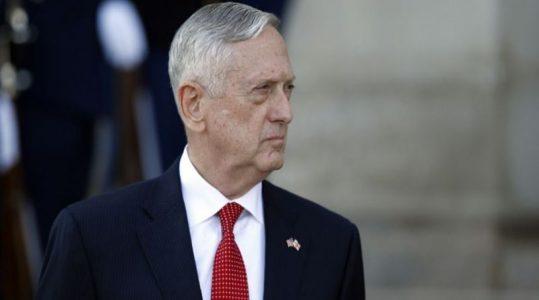
Jim Mattis: Turkish attacks slowed the offensive against ISIS in Syria
Speaking to reporters on Wednesday, US Secretary of Defense Jim Mattis explained that Turkish attacks on Kurdish areas of Syria had delayed the efforts of the US-led coalition to defeat the Islamic State (IS.)
Asked why the last phase of the assault against IS-held territory in the Middle Euphrates River Valley [MERV] was taking so long, Mattis noted that fighting can get harder as you approach the end because more of the enemy is concentrated in a smaller space.
But Mattis continued, adding, “We had the additional wrinkle of what happened in Afrin and working this out with the Turks because they kept coming in.”
Mattis’ statement marked the first time that a senior US official has said that Turkish attacks on Kurdish areas of Syria have delayed the fight against IS.
“The Syrian Democratic Forces, the SDF, who have lost thousands of troops killed and wounded fighting [IS] and pushing them down there [in the MERV] got distracted by the instability up around Afrin and Manbij, and so they were not staying fully focused,” Mattis explained.
The Kurdish-led SDF are America’s main partner in the fight against IS in Syria. Turkey considers the Kurdish component—the People’s Protection Units (YPG)—to be the Syrian branch of the Kurdistan Workers’ Party (PKK), which both Turkey and the US, as well as the European Union, consider a terrorist organization.
However, as Mattis affirmed, “We do not say the YPG is the same as the PKK.”
That was the unambiguous US position until recently, but it is now less clear. Last Friday, Amb. James Jeffrey, the Secretary of State’s Special Envoy for Syria Engagement, stated that the Kurdish component of the SDF “is in its own sense an offshoot of the PKK,” although a week before, Jeffrey had said, “We have not designated the YPG as a terrorist organization the way we have the PKK.”
Mattis also explained that the US would establish observation posts “in several locations” along the border between Turkey and eastern Syria, which is now under the control of the SDF and where US troops are located with their partner force.
“We want to be the people who call the Turks and warn them,” Mattis continued, “if we see something coming out of an area that we’re operating in.”
The Secretary of Defense emphasized that “we are consulting closely” with Turkey and the State Department.
“We are going to track any threat that we can spot” going into Turkey, he added and “we will be talking to the Turkish military across the border.
Mattis explained the purpose of this new measure, “What this is designed to do,” he said, “is to make sure that the people we have fighting down in the MERV”—i.e., the SDF—“are not drawn off that fight” and “we can crush what’s left of the geographic caliphate.”
Mattis spoke the day after Turkish Foreign Minister Mevlut Cavusoglu visited Washington, where he met with Secretary of State Mike Pompeo and National Security Adviser John Bolton.
Cavusoglu came with numerous complaints about US policy, including in Syrian Kurdistan. At a press conference for Turkish journalists at the Turkish embassy following his meetings, Cavusoglu said that Turkey and the US would be discussing how to implement the “Manbij roadmap” in other areas of SDF-controlled Syria.
However, what Mattis described was quite different. In Manbij, US and Turkish forces conduct joint patrols outside of the city. Turkish troops are actually in Syria, but as Mattis stated, in the new US plan for the Syrian-Turkish frontier east of the Euphrates, Turkish forces will remain in Turkey, across the border.
According to the plan that Mattis outlined, it seems US forces will assume, to some extent at least, the role of guarantor of quiet along that stretch of the Syrian-Turkish border, while they will be positioned to evaluate any Turkish charges of aggression from the south.
Source: Kurdistan 24





